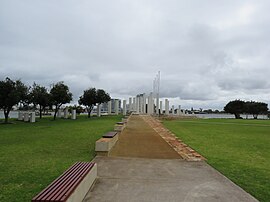
Back Mandurah Afrikaans ماندوراه Arabic ماندوراه ARZ Mandurah Azerbaijani Mandurah (lungsod) CEB مێندیۆرا CKB Mandurah Czech Mandurah Welsh Mandurah German Mandurah Spanish
| Mandurah Western Australia | |
|---|---|
 Mandurah war memorial | |
 | |
| Coordinates | 32°31′44″S 115°43′23″E / 32.52889°S 115.72306°E |
| Population | 90,306 (2021 census)[1] |
| • Density | 847.1/km2 (2,194.1/sq mi) |
| Established | 1831 |
| Postcode(s) | 6210 |
| Area | 106.6 km2 (41.2 sq mi) |
| Time zone | AWST (UTC+08:00) |
| Location |
|
| LGA(s) | |
| State electorate(s) | Mandurah, Murray-Wellington, Dawesville |
| Federal division(s) | Canning |
Mandurah (/ˈmændʒərə/) is a coastal city in the Australian state of Western Australia, situated approximately 72 kilometres (45 mi) south of the state capital, Perth. It is the state's second most populous city, with a population of 90,306.[1]
Mandurah's central business district is located on the Mandurah Estuary, which is an outlet for the Peel Inlet and Harvey Estuary. The city's name is derived from the Noongar word mandjar, meaning "meeting place" or "trading place". A townsite for Mandurah was laid out in 1831, two years after the establishment of the Swan River Colony, but attracted few residents, and until the post-war boom of the 1950s and 1960s it was little more than a small fishing village. In subsequent years, Mandurah's reputation for boating and fishing attracted many retirees, including to the canal developments in the city's south.
Along with four other local government areas (Boddington, Murray, Serpentine-Jarrahdale, and Waroona), the City of Mandurah is included in the wider Peel region. Mandurah is sometimes grouped together with Perth for statistical purposes, especially since the extension of the Kwinana Freeway and the completion of the Mandurah railway line in the late 2000s. The two cities now form a conurbation along the Indian Ocean coastline, although the Perth metropolitan area officially ends at Singleton around 9 kilometres (5.6 mi) north of Mandurah's city centre.
- ^ a b "2021 Mandurah, Census All persons QuickStats". Australian Bureau of Statistics. Retrieved 14 June 2023.